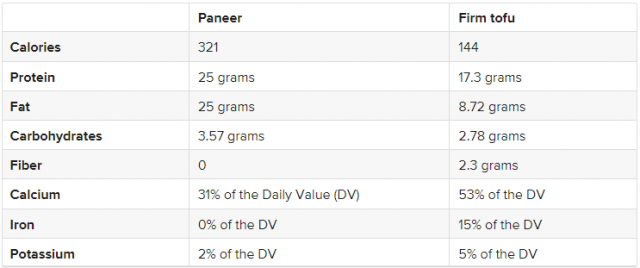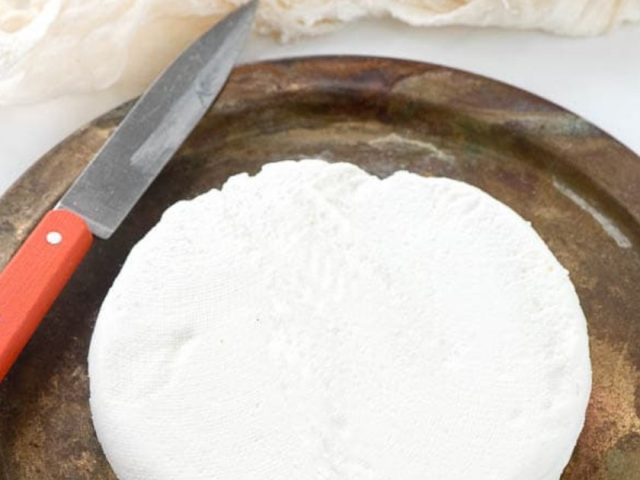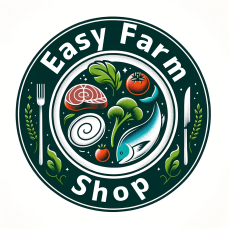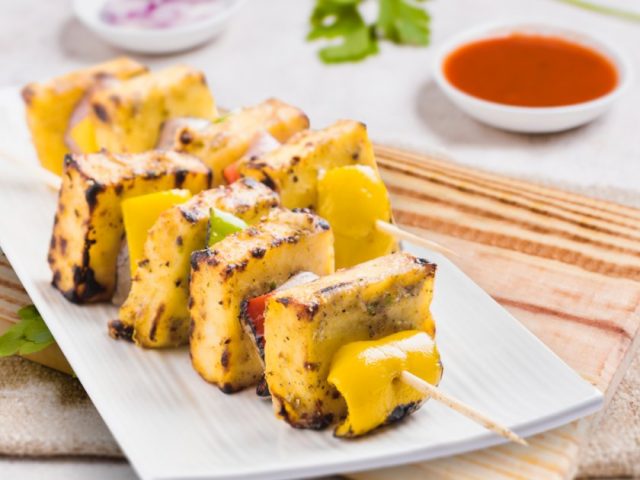Paneer is a meat substitute that is very popular with vegetarians looking for a sustainable alternative to pork, beef and chicken. Although it’s a cheese it has the advantage that unlike other cheeses it doesn’t melt when cooked and so it’s an ideal cooking alternative to diced meat.
Two of the most popular paneer dishes in the UK are paneer curry and chilli paneer. Regulars to Britain’s curry houses will also recognize these favourites:
Butter paneer, Chilli paneer, Kadai paneer, Matar paneer, Mutter paneer, Palak paneer, paneer Bhurji, paneer Butter Masala, paneer Makhani, paneer Masala, paneer Tikka, paneer Tikka Masala, Shahi paneer.
Paneer is made from whole milk by separating the curds and whey. It’s really easy to make at home ideally using organic milk from your local farm shop. You can also buy it in supermarkets for around £7.00 a kilo though it won’t taste as good.
What’s the difference between paneer and tofu
Paneer is often compared with tofu and although they have similar properties, Paneer is made from milk and so can be eaten by vegetarians but not vegans. Tofu is made from soya (a member of the pea family) and so can be eaten by both.
Paneer is traditionally used in Indian cuisine whereas tofu is predominantly used in Asian cooking.
Both products offer vegetarians an excellent source of protein and calcium. Both are also complete sources of protein, which means they contain the essential amino acids that can’t be produced by your body and so need to come from your diet.
Here are the nutritional values of 100g of each:

You might be surprised to see that plant-based firm tofu has far more calcium than the milk based paneer.
The reason firm tofu has so much calcium is that they use calcium sulfate to firm it up.
Calcium sulfate is more commonly known as Gypsum or plaster of Paris, something more often used in the building trade than in food products.
Soft tofu has far less calcium but then isn’t a direct replacement for paneer which is naturally hard.
The soya used to make tofu is a very controversial food
On one hand, it’s rich in nutrients, and diets containing it appear to be linked to health benefits, such as lower blood sugar levels, improved heart health, fewer menopause symptoms, and perhaps even a lower risk of certain cancers.
On the other hand, some people have health concerns. More than 87% of Soya is GM which many try to avoid, others fear that eating too much soya may increase the risk of breast cancer, hinder thyroid function, or have feminizing effects in men.
Soya is also a major contributor to climate change, most soya (over 80%) is grown in the Americas making it a very high “food miles” product for the British customer. It is also a major contributor to the climate change problems of deforestation, soil erosion, and water shortages.
Is paneer the same as cottage cheese?
The only difference between paneer & cottage cheese is that while paneer is unsalted, cottage cheese is salted and may sometimes have heavy cream in it. The process of making the cheeses are the same though the supermarket prices are very different as cottage cheese costs around £3.50 a kilo whereas paneer is twice the price at an average of £7.00 a kilo.
How to make paneer at home

Homemade paneer will taste far better than store-bought, especially when you use organic farm shop whole milk. It’s really fast and easy to make and you get the benefit of having lots of healthy whey as a byproduct, keep reading to find out how to use your leftover whey.
You should use your homemade fresh paneer within a few days. If you’re using it in a chilli paneer or paneer curry it’s probably ok to use after 4 or 5 days but as with everything natural fresh is best.
Store it in the fridge, but make sure to remove the cheese from the cheesecloth and store it in an airtight container otherwise it will dry out.
You can freeze paneer and it will keep for several months.
Here’s the recipe:
Equipment needed
Fine cheesecloth, colander
Ingredients
2 litres of Organic Farm Fresh whole milk (not UHT Pasteurised)
6 tablespoons lemon juice or white vinegar
Instructions
Pour the milk into a large pot and bring to a boil over medium heat.
While the milk is boiling, prep the lemon juice or vinegar. If you are using vinegar mix it with 1/4 cup water so it’s not so intense when you pour it into the milk.
Once the milk has boiled turn off the heat and pour in the lemon juice or vinegar. Give it a stir, and the milk should curdle immediately.
If it doesn’t curdle you can add another tablespoon of lemon juice or vinegar.
Let the contents of the pot cool for 10 minutes or so.
Line a colander with the cheesecloth and place the lined colander into the sink.
Strain the milk curds through the cheesecloth. Rinse the curds under cold water to wash out the lemon juice or vinegar.
Gather up the corners of the cloth; twist the cloth so that the soft cheese is in the shape of a ball. Squeeze out the excess water.
Shape the cheese into a disc – put the wrapped cheese on a plate and weigh it down with a small stack of plates on top. The idea is to squash out any excess liquid and to turn the ball into a disc (like round brie)
Let it stand in the fridge with the plates on top for 1 to 2 hours.
Once chilled, your paneer is ready for cooking, eating cold, or freezing.
What to do with the Whey That Gets Leftover When You Make Paneer!
You’ll use around 7 litres of milk to make 1Kg of paneer. About 80% of the volume of milk used remains as whey. Whey is the slightly yellowish liquid that gets leftover when you make your own paneer. (It’s also the liquid component in yogurt).
Whey is a very healthy way to add more protein to your diet. It’s a quality protein source that is absorbed and utilized efficiently by the human body. This is particularly important for athletes, bodybuilders, or people who need to gain muscle mass and strength while losing fat
It’s also a complete protein as it contains the nine essential amino acids that our body cannot produce on its own. This is especially important for vegetarians who sometimes struggle to get all the proteins they need.
Whey is very good for your health so rather than throw it away check out these great ways to incorporate it into your health and fitness regimes
First of all, here’s how whey can help you stay healthy
- It builds muscle strength. (Bodybuilders drink A LOT of Whey).
- It provides cellular energy.
- It strengthens your immune system.
- It may prevent diseases like cancer and HIV.
- It may lower blood pressure to healthy levels without the side effects of some blood pressure medications.
- It may reduce the risk of thrombosis, helping to prevent heart attacks and strokes.
- It may improve prostate health and prevents prostate cancer.
- It may promote healthy gut bacteria and inhibits harmful bacteria.
- It cleanses the bladder and may help prevent bladder infections.
- It may correct hormonal imbalances.
- It may slow down the effects of ageing.
- It may promote weight loss.
- It improves digestion.
- It supports healthy kidney function.
The protein in whey is so powerful that many gym-goers and bodybuilders rely on it as part of their pre and post-workout programmes. They often rely on artificial whey, which has both health benefits and negative side effects. The whey in paneer and yoghurt is natural and less likely to have side effects
Here are a few ideas for the whey that gets leftover when you make your paneer.
Add whey to fruit and vegetable juices and smoothies
If you drink juice every morning, use whey to make the juice instead of water.
Use it to cook rice, pasta, or vegetables
If you have lots of whey and need to use it up quickly, use it to boil your rice, pasta, or veggies.
Incorporate whey in your baking.
If you’re baking something, replace the water content in the recipe with whey to make it a little healthier. Bread, cakes, pancakes, or muffins – whey goes well with all of them.
Add it to soups.
Use whey as the base for soup instead of water or stock.
Use it as a hair conditioner.
The protein in the whey will do wonders for your hair! Shampoo and then apply the whey. Massage it into your scalp and hair. After 10 minutes rinse off with lukewarm water.
Take a whey bath to soften your skin.
Some spas actually offer whey baths, because whey cleanses, softens, moisturises and tones the skin. It is gentle, anti-microbial and slightly acidic, which is good for the pH balance of your scalp, hair and skin.
Add 1 – 2 cups of whey in your bath water and soak in it for 20 minutes, rinse off under the shower.
Add it to your dogfood
Add some whey to your dog’s food to give an extra protein boost. Be careful not to give them too much or it may upset their digestive system.
Use whey to water your plants
Make a weak dilution of whey with water and pour it into your plants. Diluting it is important because whey is quiet and could burn your plants.
I hope I’ve inspired you to get down to your local farm shop, stock up on organic milk and start making your own vegetarian paneer this January.

